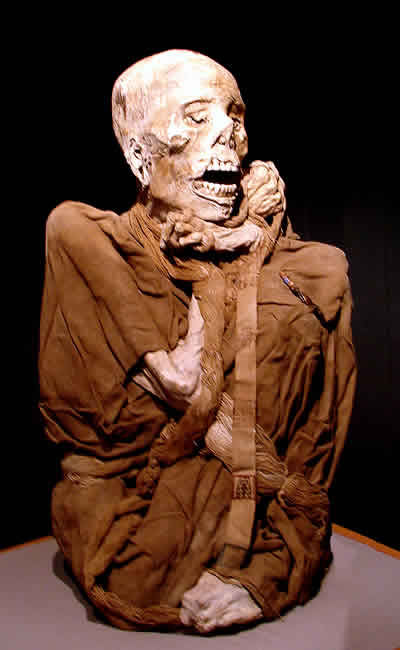CHACHAPOYAS CULTURE
In the year of 1535, the first Spaniards arrived at the territory of the Chachapoyas, an enormous region located between the rivers Huallaga and Marañón, between 2,000 and 3,000 mts. of altitude and cover permanently by clouds. From century IX, the zone was populated by an important culture, until it was invaded by the Incas in century XV, and incorporated to the Inca Empire, during the times of Túpac Inca Yupanqui.
The Chachapoyas town or Sachapcollas (settler of wooded zones) was integrated by diverse compatible ethnic groups, that moved by the territory that extends from the North to the South (about 300 km), from the Marañón in the zone of Bagua and the river basin of the Abiseo by the South.
Some hypotheses assure, that the Chachapoyas descended culturally from Andean immigrants, who modified their ancestral culture in a new environment, taking some traditions from the settlers of amazonian origin. They transformed the jungle landscape into desert as they were depredating the forests, and as resulting from the annual burn which it was a common practice.
POLITICAL AND SOCIAL ORGANIZATION OF THE CHACHAPOYAS
The unit of social organization was constituted by great provinces controlled each one by a powerful "cacique" and totally independent to each other. They were a small seated kingdoms or "señoríos" mainly to borders of the Utcubamba River. All had the same language, the same customs and forms to cultivate and, very occasionally, were joined for some religious ceremonies or to defend itself of the attack of an enemy town, always maintaining their autonomy.
According to chronicles related by "Pedro Cieza de Leon", the Chachapoyas were whitest and attractiveness of all the inhabitants of Peru. They dressed wool clothes and they took in its heads “llautos” in signal of its origin. After its annexation to the "Incario" they adopted the customs imposed by the "cusqueños".
The social organization was based on the domestic production and the agricultural subsistence with storage facilities. Within the region of Chachapoyas, they developed the food interchange (like the salt) and services, based on the social relations where the populations were joined in a work network.
ARCHITECTURE AND CERAMICS CHACHAPOYAS
The central zone of the development of the Chachapoyas Culture was the river basin of the Utcubamba. There we can find the sets architectonic of "Olán", "Yalapé", "Purunllacta" or “Monte Peruvia”, "Congón" (renamed like "Great Vilaya"), "Vira Vira", "Pajatén" and others. Pero Kuélap is, without a doubt, the hugest monument, of almost 600 meters from length and walls that reach 20 meters of top.
The habitable constructions and monumentals are circular with high bases, great stone cornices and flat stones excelling on the surface of the bases. They have inclined ramps or stairs, directed towards the entrance.
The Chachapoyas developed a common symbolic language with geometric reasons in form of triangles, rhombuses, wound and square ornamentos, that appear in the frisos of stone of the circular houses. These symbols had an ethnic and social value, and served to demonstrate the force of local identity, maintained through Inca period.
Also the funeral architecture characterizes to the Chachapoyas Culture and includes two types of graves: sarcófago and the mausoleum. Sarcófago is a evolution of undertaker "fardo" that is expressed in "cordilleranos" and "costeños" spaces of the Tiahuanaco and Huari times.
Source: http://www.tudiscovery.com/mochica_chacha/cultura_cha/index.shtml

MUMMIE OF CHACHAPOYAS CULTURE
Next a sample of images caught in a exhibition in the "Museum of Nation", in the city of Lima, about the Leymebamba Mummies.
• Textile.
• Ceramic.
• Handicraft.
• Bony Rest.
• Children Mummies.
• Leymebamba Mummies.
Página web creada el 30 de marzo del 2005.
© Copyright 2005 Gualberto Valderrama C.
|
 SPANISH
SPANISH

 SPANISH
SPANISH
